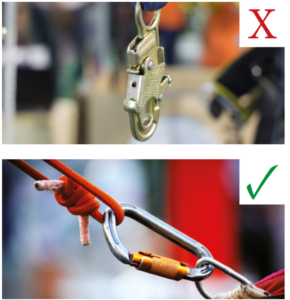The Charity
Aviation
Maritime
M2128

Initial Report
While at anchor, the chief officer went outboard to inspect the windows as part of a routine maintenance check. He wore the appropriate PPE in accordance with the requirements of the Permit to Work (PtW), a harness with an attached safety line, a lifejacket, and a helmet. After doing his buddy checks, he went outboard to inspect the windows.
He realised he was missing one carabiner and grabbed a quick-release shackle, which was used as the primary point for connecting to the vessel. A little while later, a deckhand found the chief officer swimming behind the boat. The chief officer reported that during the inspection, he had accidentally knocked the quick-release shackle, which released the safety line causing him to fall into the water.
CHIRP Comment
The chief officer was following the permit-to-work requirements and used a crew member (buddy) to ensure that the gear was being worn correctly in accordance with the PtW, which is commendable. However, picking up a quick-release shackle instead of a carabiner and using it as the main securing point created a single point of failure which inevitably led to the fall from height.
CHIRP stresses that working at height PPE should be kept separate from other lifting or securing gear. This gear should be stored in clean, secure compartments and regularly scrutinised for damaged.
The PtW requirements were not followed properly because anyone working at height must be fully supervised during the work. No other work activity should be undertaken which takes away that essential duty. It’s important to ensure that the crew are trained on the full requirements of the PtW system so that the full process is followed. In previous FEEDBACK editions, CHIRP has emphasised that when crew are working aloft a rescue plan must always be prepared as part of the risk assessment. Crew members who fall and are suspended by their safety harness must be rescued within 15 minutes to avoid serious injury or even death due to blood circulation being constricted.
Key Issues relating to this report
Communications– Clear communications must be provided to the crew who is spotting the person working aloft. When your crew work aloft, do you have crew spotters who know what to do if a person is suspended by the safety harness?
Distractions– Nothing should distract the person attending to the crew working aloft. Use additional crew who have been briefed about the work and the PtW if the spotter can only sometimes be there.
Teamwork- Work as a team and share what will happen with those assigned to the work. Making sure that the equipment that is going to be used for the job is correct and in good condition.
Pressure- the chief officer placed pressure on themselves to carry out the task with inappropriate equipment – a quick-release shackle is not a suitable replacement for a carabiner!
This data type is not supported! Please contact the author for help.






